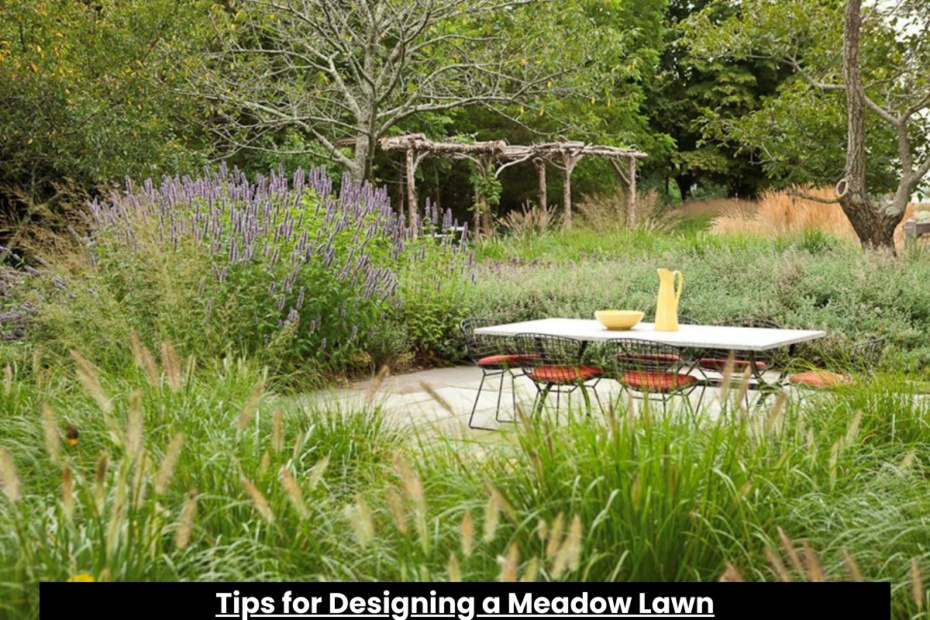You may make your outdoor space more colourful, low-maintenance, and environmentally beneficial by designing a meadow lawn. The following eight essential guidelines will assist you in designing a lovely and useful meadow lawn:
Select the Appropriate Site
The choice of site is crucial to the success of a meadow lawn. Meadows prefer full sun to mild shade, so check how much sunshine your region gets during the day. Take drainage and soil type into account as well. In general, well-drained soils are preferred by meadows;
if your soil is rich in clay or has poor drainage, you may need to amend it with sand or organic matter to increase soil fertility and drainage.
Also See: How to Use Compost in the Garden to Combat Intense Heat and Drought
Chose the Right Native Plants
A meadow lawn that is successful must have native vegetation. They give local species a home and food because they are acclimated to the local environment. Look into native plants that grow well in your particular soil and light circumstances.
A varied and hardy meadow will be produced by a blend of grasses and wildflowers. Coneflowers, black-eyed Susans, and milkweed are among the wonderful options for wildflowers, as are grasses like bluestem, switchgrass, and fescue.
Make a Diversity Plan
A varied meadow creates visual interest and is home to a variety of creatures. A variety of plant heights, hues, and blooming seasons should be considered. Because of its richness, your meadow will remain beautiful for the whole year and continue to serve as a habitat for wildlife and pollinators.
To create a landscape that is both realistic and aesthetically beautiful, try to strike a balance between grasses and blooming plants.
Set Up the Soil Correctly
Establishing a meadow lawn requires proper soil preparation. First things first, remove any weeds and grass that are present. Mowing, tilling, or using a non-selective herbicide are among methods for doing this. After clearing, examine the soil to determine its pH and nutrient content.
To get the right pH and nutrient balance for the plants you have selected, amend the soil as necessary. A pH of 6.0 to 7.0 is considered mildly acidic to neutral, and well-draining soil is ideal.
Incorrectly Sow Seeds
A crucial first step in establishing a meadow grass is planting seeds. For a more uniform dispersion, you can either scatter the seeds by hand or with a seed spreader. For planting depth and spacing, refer to the instructions on the seed packet.
To guarantee optimal seed-to-soil contact, seeds should typically be placed on the soil’s surface and gently raked in. Before planting, try combining the seeds with a carrier, like as sand, to increase germination rates. This aids in a more uniform distribution of the seeds.
Develop a Maintenance Schedule
Meadows need less upkeep than standard lawns, but they still need some attention to be healthy. In order to aid in the seeds’ germination and root establishment, you will first need to water the area often. Meadows usually require less water once grown than regular lawns.
It’s imperative to mow or cut regularly to keep aggressive plants under control and promote the emergence of new species. To keep the meadow looking good and staying healthy, try to mow it just once or twice a year, usually in the late fall or early spring.
Encourage Biodiversity
Incorporate elements such as native bushes, butterfly houses, and birdbaths into your meadow design to promote biodiversity. These components improve your meadow’s ecological value and provide habitat for a greater variety of wildlife.
Furthermore, stay away from artificial pesticides and fertilisers as they might destroy beneficial insects and upset the equilibrium of the ecosystem.
Acknowledge Seasonal Variations
A meadow lawn exhibits seasonal variations in its dynamic landscape. Consider these shifts and choose plants that will provide interest all year round. For winter visual interest, select plants with colourful stems or eye-catching seed heads.
To make sure that your meadow looks good all year round, account for seasonal variations in texture and colour as well.
Final Thoughts
It takes careful planning and a dedication to producing a beautiful and sustainable landscape to design a meadow grass.
Through careful site selection, native plant selection, soil preparation, and upkeep, you can create an aesthetically pleasing and useful outdoor area that helps local animals as well as yourself. Accept the innate beauty of meadows and allow colour, texture, and life to bloom in your outdoor space.
